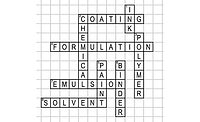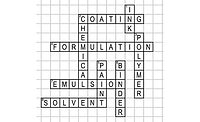Editor’s Note: Following is Keith Moody’s answer to the problem presented in “Polly’s Botched Scale Up” in the August 2018 issue of PCI.
Polly Mertz's first scale-up of a new emulsion polymer had resulted in the contents boiling out of a 500-gallon reactor. What had gone wrong in the acrylic emulsion production batch? Why did Al Kidd ask for Polly’s attendee name tag from the 2018 Waterborne Symposium? How was Al able to quickly solve the conundrum with the help of the badge?
Al needed the name tag from the Waterborne Symposium because it had a small magnet to hold the tag onto clothing instead of a pin. Al knew that the maintenance group was supposed to use 300-type stainless steel on the reactor. He also knew that this 300-type stainless steel was nonmagnetic. However, Al also knew that there was a rush to get the redox solutions connected before Polly returned from the Symposium. Al knew that engineering had taken parts off an old alkyd reactor no longer in use instead of ordering new parts.
Al was able to use the small magnet to detect magnetic parts used to connect the redox solution. He was able to locate an elbow, no longer than 4 feet, which was magnetic and therefore not 300-type stainless. It didn’t take long to work his way around the reactor with the magnet and determine that the elbow was made from magnetic high-iron carbon steel. Old alkyd reactors were made from low-alloy steel with high iron. The old solvent-based alkyd reactors didn’t require 300-type stainless steel. However, the new emulsion reactors that use water as the reaction solvent require the more expensive, 300-type stainless steel construction.
All redox systems are susceptible to ionic contamination that can deactivate the free radical solutions used to kick off the acrylic poly-merization. That is why the water used in emulsion polymerization has to have low amounts of metal and often uses expensive deionizer systems to ensure water purity. However, because of the carbon steel elbow used in connecting the redox solution, there were enough Fe ions inside the elbow washed by the aqueous redox solution to kill the redox system. Without the redox system generating the needed free radicals, the polymerization of the acrylic monomers didn’t occur. The redox system was compromised and this caused a large buildup of unreacted monomer in the emulsion reactor. Once enough free radicals were eventually generated to start the acrylic polymerization, there was so much unreacted monomer in the system that the reaction took off. The reaction of monomer polymerizing at one time caused a very large exotherm, which boiled the water and caused the emulsion to literally “boil over” and out of the reactor. The huge amount of energy in this boiling water was sufficient to push the reactor hatch lid up and open, emptying most of the contents of the reactor on the plant floor. Once the small elbow made from carbon steel was replaced with a 300-type stainless steel connector, the batch ran without incident and in specification.
For more information about emulsion polymerization and reaction kinetics, see the August 2017 issue of Paint & Coatings Industry magazine, “Redox for Main Polymerization of Emulsion Polymers” by Paul Fithian of BruggemanChemical U.S. Inc.







